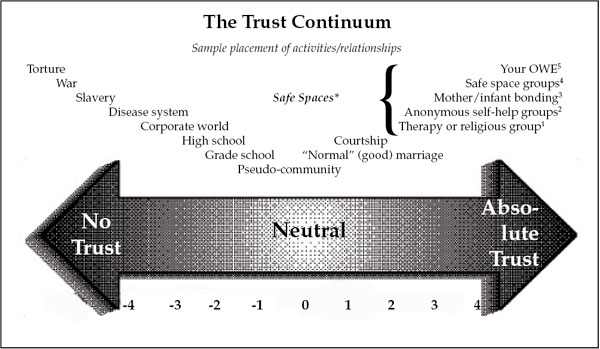 |
|
 |
The Trust Continuum
![]() 
* Note: We have not included marriage or courtship as safe spaces because partners in these relationships are typically withholding what they fear to be “unacceptable” parts of themselves.
- One of the most common experiences of safety is found in situations where a strong (usually male) figure is in charge and encourages one to bear her soul (confession or therapy situations).
- Various self-help groups are rapidly developing across the country based on the 12-Step approach. Members of these groups remain anonymous and “cross-talk” is prohibited (to short-circuit conflict and judgmentality). Such constraints do allow a greater degree of safety than is normally experienced in groups, but do so by severely limiting the communication.
- Those fortunate enough to have had a strong, healthy, loving, bonding with their mother in infancy (or provide it to an infant of their own), have a special experience of safety with another person that can be helpful as a reference point in helping create other contexts for safe spaces to be experienced.
- Groups which focus on community building and the development of conflict resolution skills can create environments where members experience ever increasing levels of safety. They do this by removing the constraints necessary for creating safety in the previously mentioned examples. Such groups are described in detail in later sections.
- An OWE has all the characteristics of safety developed in the previous group, but with people specifically chosen to challenge, inspire, and nurture.
|
 |
 |
|
 |
|
 |
|
 |
|
 |
|
 |
|
|
|
|
|
|
 |
|
 |
|
 |
 |
 |
 |
| |
 |
|
|
 |
Child/Family Wellness
Honoring the heart, soul, and spirit of our children, our families, and our future. After more than three decades of pioneering work in adult wellness, and giving birth to a daughter, Siena, in 1993, Meryn and John realized that the more... |
|
 |
|
|
 |
|
 |


